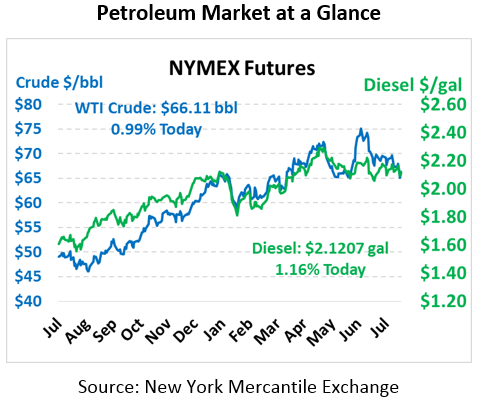
Will Electric Vehicles really be the next step in fuel efficient technology?
Analysis by Madi Burton & Noah Bartz
Prices are moving higher this morning, but are still set to end the week in the red. The market continues to digest this week’s bearish inventory data amid an uncertain global market and geopolitical tension. Crude oil traded up 51 cents and is continuing its upward movement this morning. Crude prices have gained 65 cents to trade at $66.11 currently.
Fuel prices are also trading in positive territory this morning. Products saw mixed results yesterday with diesel trading mostly flat and gasoline sinking lower. This morning, however, both products are trading in the same direction with diesel leading the way higher. Gasoline prices have broken back above $2 and are trading at $2.0015, a gain of just over a penny. Diesel prices have gained over 2 cents to trade at $2.1207.
Will Electric Vehicles really be the next step in fuel efficient technology?
Electric vehicles are viewed in today’s culture as the ideal image of clean and efficient energy. They are the “vehicle of the future”, rapidly approaching with each new technological breakthrough. The question has shifted from if EVs will be a part of our future, and now is to what extent and when?
Many writers postulate that the EV market will grow rapidly while the Internal Combustion Engine (ICE), a mature and century-old technology, becomes obsolete in the coming decades. In reality, the two technologies will likely coexist for the near future. Although EV technology is making advancements and its market share is growing, the ICE has continually shown signs of growth and improvement.
The Skyactiv-X Engine
Mazda Motor Corporation has developed a gasoline engine capable of providing the efficiencies of a diesel engine, while producing less emissions. This engine would increase fuel efficiency by 20-30% running on traditional 87 octane gasoline. Utilizing what Mazda calls “spark controlled compression ignition” they developed a prototype others have been researching for years. Engineers developed a computer technology to monitor numerous variables in the engine and prevent the dreaded engine knock. Mazda is calling this engine the Skyactiv-X, which will be used in production as soon as next year.
What does this mean for fuel prices?
If compressed ignition is truly nearing deployment, the fuel industry should be watching. Assuming production goes according to plan, other motor corporations and businesses will have access to the design within a year to develop their own version. An increase of 20-30% fuel efficiency across the market could result in massive changes for the current fuel landscape. A widespread reduction in gasoline usage would draw down demand, likely bringing prices with it, though at a gradual rate – that is, assuming gasoline production remains at the same level. Both EVs and ICEs have the potential to take significant fuel volume off the market, eventually putting downward pressure on fuel prices.
The EV market is in the public eye and is expected to change the energy industry in a big way. In contrast, Mazda’s engine hasn’t had the spotlight; yet if viable, it has the capability to change the market as well. Just as low oil prices from 2015-2017 squashed interest in alternative fuels for a brief period, Mazda’s innovation could bring about a renaissance of high-efficiency, low-cost ICE vehicles to compete with EVs, potentially slowing the need for mass conversion to electric vehicles.

This article is part of Crude
Tagged:
MARKET CONDITION REPORT - DISCLAIMER
The information contained herein is derived from sources believed to be reliable; however, this information is not guaranteed as to its accuracy or completeness. Furthermore, no responsibility is assumed for use of this material and no express or implied warranties or guarantees are made. This material and any view or comment expressed herein are provided for informational purposes only and should not be construed in any way as an inducement or recommendation to buy or sell products, commodity futures or options contracts.





